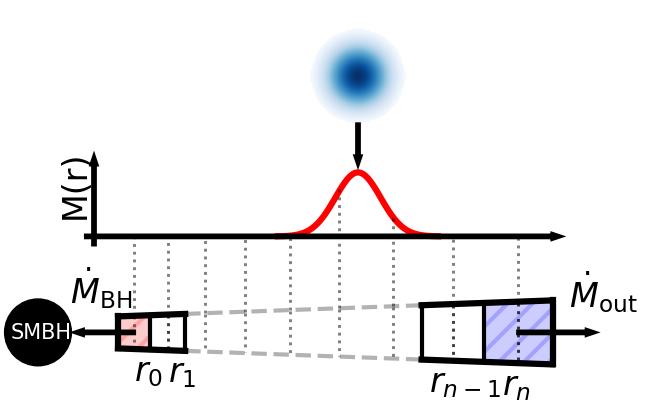A simple model of a thin alpha-accretion disc. We use Paczyńsky-Wiita (PW) potential:
to arrive at and solve the viscous diffusion equation:
assuming a stable thin accretion disc.
Accretion disc is fed by distributing packets of gas over annuli comprising the disc about some chosen radius.
This is meant to iliustrate accretion of SPH particles onto an accretion disc sink particle used in hydrodynamical code Gadget-3.
Package is managed with Poetry:
poetry installPoetry should manage dependencies automatically. If for whatever reason it does not a combination of:
- numba
- numpy
- matplotlib is required to run the model and examples, although matplotlib is only used for plotting.
The main model dataclass and functions are in disc.py. Model makes use of code units and some constants found in units.py.
A quick example below:
import accretiondisc.disc as ad
import accretiondisc.units as unt
# accretion disc is initiated with
# (default values in given example in code units)
disc = ad.Disc(
bh_mass=0.8, # SMBH mass
n_rings=200, # number of rings comprizing the disc
mdot=0, # SMBH accretion rate
mesc=0, # amount of matter that escaped the disc
rin=1.147e-06, # inner boundary, assumed ISCO
rout=0.01, # outer boundary
ctime=0.01, # courant factor
disc_alpha = 0.1, # accretion disc alpha (~0.1 is ok)
h_r_init=0.002, # height to radius ratio
PW=True # using Paczyńsky-Wiita potential
) # diffusion reduces to Kepler if False
# a simulation of steady accretion over a period
# of time is performed with "do_the_evolution" function;
# it returns disc object at the last step and some storage arrays
(disc, # disc object
sigma_arr, # surface density
ring_luminosity_from_teff_arr, # luminosity from Teff
ring_luminosity_from_mdot_arr, # luminosity from mdot
nu_arr, # viscosity
tau_arr, # optical depth
bh_mass_arr, # SMBH mass
mesc_arr, # escaped mass
mass_arr, # mass of the disc (sigma * area)
bh_mdot_arr, # SMBH accretion rate
temperature_effective_arr, # effective temperature
temperature_center_arr, # central temperature
current_time_arr # time in code units
) = ad.do_the_evolution(
disc, # disc object
total_time=75, # total time of simulation run
fraction_of_time_feed=0.2, # fraction of time that the disc is fed
total_mass_to_feed=0.02, # total mass fed to the disc
dt=5e-3, # "outer" timestep - intervals between
# disc feeding, diffusion step determination and data storage
mass_portion=8e-8, # size of mass portion (discrete SPH particle)
hsml=0.01, # smoothing lenght (minimum in an SPH simulation)
r_circ=0.003 # mass insertion radius
)An example of a unit mass spreading by diffusion in a disc with constant viscosity is in examples/diffusion_example.py. Results should be compared to Fig. 5.1. (page 83) Accretion Power in Astrophysics or Fig. 1. from Accretion discs in astrophysics
An example of steadily accreting disc model is in examples/steady_accretion_example.py.
This repository uses the MIT license.
See the LICENSE file for license rights and limitations (MIT).

